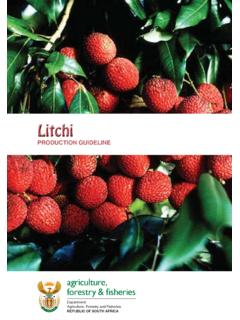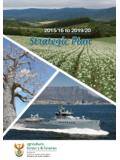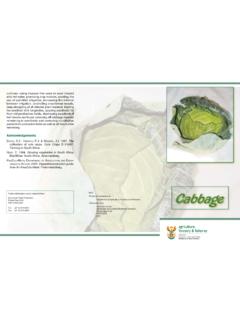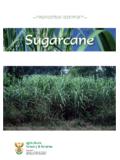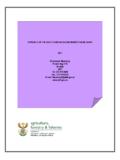Transcription of IRRIGATION STRATEGY FOR - Department of …
1 Ii iii IRRIGATION STRATEGY FOR SOUTH AFRICA MARCH 2015 i FOREWORD ii EXECUTIVE SUMMARY The IRRIGATION STRATEGY identifies objectives, priorities, allocates responsibilities and ensures coordinated efforts and estimates realistic funding, as well as sets out the principles for initiatives which are being undertaken to revitalize and expand IRRIGATION schemes in the country. The IRRIGATION STRATEGY is a response to the call for the sector to increase its contribution to agricultural production thus ensuring food security, poverty alleviation and job creation.
2 This document includes directives from recent policy changes and provides directions for institutional reform and guidelines on public investment in IRRIGATION initiatives. This STRATEGY aims to coordinate, align and avail all programmes that target support and development of IRRIGATION farmers towards achieving optimum utilisation of resources for sustained food security and economic returns. The focus is on subsistence farmers so as to address the inequities resulting from past policies, but this has a number of important dimensions, which will be explored in this document. Most importantly the STRATEGY recognises that the Department of Agriculture, Forestry and Fisheries (DAFFs) policy initiatives have been aimed at achieving the objectives of Outcome 4, Outcome 7 and Outcome 10 of the Medium Term Strategic Framework (MTSF) relating to job creation, food security and rural development.
3 Furthermore the STRATEGY provides a link between policy and practical implementation in a structured way. It ensures coordination by inclusion of important areas such as Strategic Infrastructure Project (SIP) 3, 4, 5 and 11. IRRIGATION has a potential to increase food production thus contributing to the Agricultural Policy Action Plan (APAP) which is guided by the 2030 Vision statement of the National Development Plan (NDP) and the New Growth Path (NGP). The plan is based on the model of the Industrial Policy Action Plan (IPAP) and seeks to translate the high-level responses offered in the Integrated Growth Development Plan (IGDP), into tangible, concrete steps.
4 Iii ACKNOWLEDGEMENTS The Department would like to acknowledge and thank all those who contributed to the IRRIGATION STRATEGY . DAFF would like to thank Mr Felix Reinders for the use of the IRRIGATION pictures. Contents Chapter 1: INTRODUCTION .. 1 Purpose and objectives of the IRRIGATION STRATEGY .. 2 Alignment with National Strategic Imperatives .. 5 Scope and benefits of irrigated agriculture in South Africa .. 9 History of IRRIGATION in South Africa .. 11 Chapter 2: NATURAL RESOURCE BASE FOR IRRIGATED AGRICULTURE IN SOUTH AFRICA .. 16 Rainfall and runoff .. 16 Groundwater .. 17 Soils .. 19 General strategies relating to resource surveys, land suitability and land use planning.
5 21 Chapter 3: INSTITUTIONAL ARRANGEMENTS .. 26 Role Players and their functions .. 26 Institutional Structures Government structures .. 29 Institutional structures between government and other stakeholders .. 30 Financial assistance .. 30 Institutional structures - Joint ventures .. 32 Intervention measures .. Chapter 4: IRRIGATION RESEARCH, EXTENSION AND ADVISORY SERVICES .. 34 IRRIGATION research .. 34 IRRIGATION extension and advisory services .. 35 Intervention measures .. Chapter 5: REVITALIZATION OF IRRIGATION SCHEMES .. 37 Lessons learnt from revitalization initiatives of the recent past.
6 38 Intervention measures .. Chapter 6: DEVELOPMENT OF NEW IRRIGATION SCHEMES .. 41 Possible areas .. 41 Intervention measures .. Chapter 7: HOUSEHOLD AND COMMUNITY FOOD GARDENS .. 45 Rainwater harvesting (RWH) .. 45 Types of RWH .. 46 Intervention measures .. Chapter 8: MANAGEMENT IN IRRIGATED AGRICULTURE .. 50 IRRIGATION water management .. 50 General management of IRRIGATION farming .. 51 Intervention measures .. 52 Chapter 9: CONCLUSION .. 53 REFERENCES .. 54 Annexure A: Land Capability 61 Annexure B: Funding Requirements for IRRIGATION .. 63 ABBREVIATIONS APAP Agricultural Production Action Plan ARC Agricultural Research Council ARC-IAE Agricultural Research Council - Institute for Agricultural Engineering bfap Bureau for Food and Agriculture Policy CASP Comprehensive Agricultural Support Programme CEO Chief Executive Officer CCAW Coordinating Committees on Agricultural Water DAFF Department of Agriculture.
7 Forestry and Fisheries DEA Department of Environmental Affairs DED Department of Economic Development DRDLR Department of Rural Development and Land Reform DWS Department of Water and Sanitation EIA Environmental Impact Assessment EXCO Executive Committee of the DAFF FAO Food and Agriculture Organization FEW Food, Energy and Water Nexus GCIS Government Communication Information System GDP Gross Domestic Product GHG Greenhouse Gasses GNP Gross National Product GSSA Geological Society of South Africa HDIs Historically Disadvantaged Individuals IGDP Integrated Growth and Development Plan IPAP Industrial Policy Action Plan MAFISA Micro Agricultural Financial Institution of South Africa MAR Mean Annual Rainfall MTSF Medium Term Strategic Framework NDP National Development Plan NEMA National Environmental Management Act NGO Non-Governmental Organization NGP New Growth Path NWA National Water Act NWRS
8 2 National Water Resource STRATEGY Second Edition PDA Provincial Departments of Agriculture PDALF Preservation and Development of Agricultural Land Framework PICC Presidential Infrastructure Coordinating Committee RESIS Revitalization of Small-Scale Holder IRRIGATION Schemes RWH Rain Water Harvesting SANCID South African National Committee on IRRIGATION and Drainage SAPWAT South African Procedure for Estimating IRRIGATION Water Requirements SIP Strategic Infrastructure Projects SIS Smallholder IRRIGATION Schemes WAR Water Allocation Reform WARMS Water Registration Management System WMA Water Management Area WRC Water Research Commission WUAs Water Users Associations WUE Water Use Efficiency WUIWG Water Use and IRRIGATION Working Group 1 Chapter 1: INTRODUCTION The Republic of South Africa covers an area of 122 081 150 ha in total of which approximately 14 million ha (13%) is cultivated land ( bfap , 2011).
9 It is estimated that about 35% of the people in South Africa are directly or indirectly dependent on agriculture for employment and income (GCIS, 2011). The sector contributes about to the GDP and 7% to formal employment. The agricultural sector is made up of commercial farmers, smallholder and subsistence farmers (DWA 2013, now DWS). It is estimated that 1, 6 million ha is under IRRIGATION where about 50 000 ha is located in the previous homelands and is allocated to smallholder farmers. According to the National Water Resources STRATEGY 2 (NWRS2), the agriculture sector uses about 60% of the water withdrawals.
10 The IRRIGATION STRATEGY will act as a link between policy and practical implementation of the policy in a structured way and will further outline the approaches and steps required to achieve the policy objectives. The STRATEGY aims to prevent uncoordinated, fragmented development that would lead to inefficient and conflicting resource use. The following focus points of the IRRIGATION STRATEGY will take into consideration the natural resource base and remain as thrusts that ensure that the objectives are achieved: Institutional arrangements; IRRIGATION research, training, extension and advisory services; Revitalization; New development; and Increased management and efficiency of water use.

